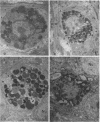Abstract
Using an antiserum (LR-1) raised against mammalian gonadotropin-releasing hormone (GnRH), we previously identified a nonneuronal cell that was more numerous in the medial habenula (MH) of courting ring doves than in individuals housed in visual isolation. The current studies suggest that they are mast cells. Both acidic toluidine blue and toluidine blue dissolved in water/butanediol revealed metachromatic cells with a distribution and morphology similar to that obtained by immunostaining with the GnRH antiserum in the MH. Some cells had granules reactive to safranin in the presence of alcian blue, indicative of a highly sulfated proteoglycan of the heparin family. Immunocytochemical studies demonstrated that all MH cells containing GnRH-like immunoreactivity contained histamine, another mast cell marker. The GnRH-immunoreactive cells had a unilobular, ovoid nucleus. Secretory granules within the cells were electron dense and displayed a variety of internal structures. Fine filamentous processes appeared evenly distributed on the cell surface whether cells were located on the pial surface or within the brain parenchyma. All of these features are characteristic of mast cells. To test whether the epitope recognized by the GnRH antiserum was produced by the mast cells or endocytosed from the cerebrospinal fluid, an iodinated GnRH analog was injected intracerebroventricularly at the initiation of courtship. Radioautography revealed no radioactive cells in the brain, indicating that the GnRH antibody recognized a molecule synthesized by the nonneuronal cells rather than internalized by a receptor-mediated mechanism. These observations suggest an interaction between a component of the immune network and specific regions of the central nervous system.
Full text
PDF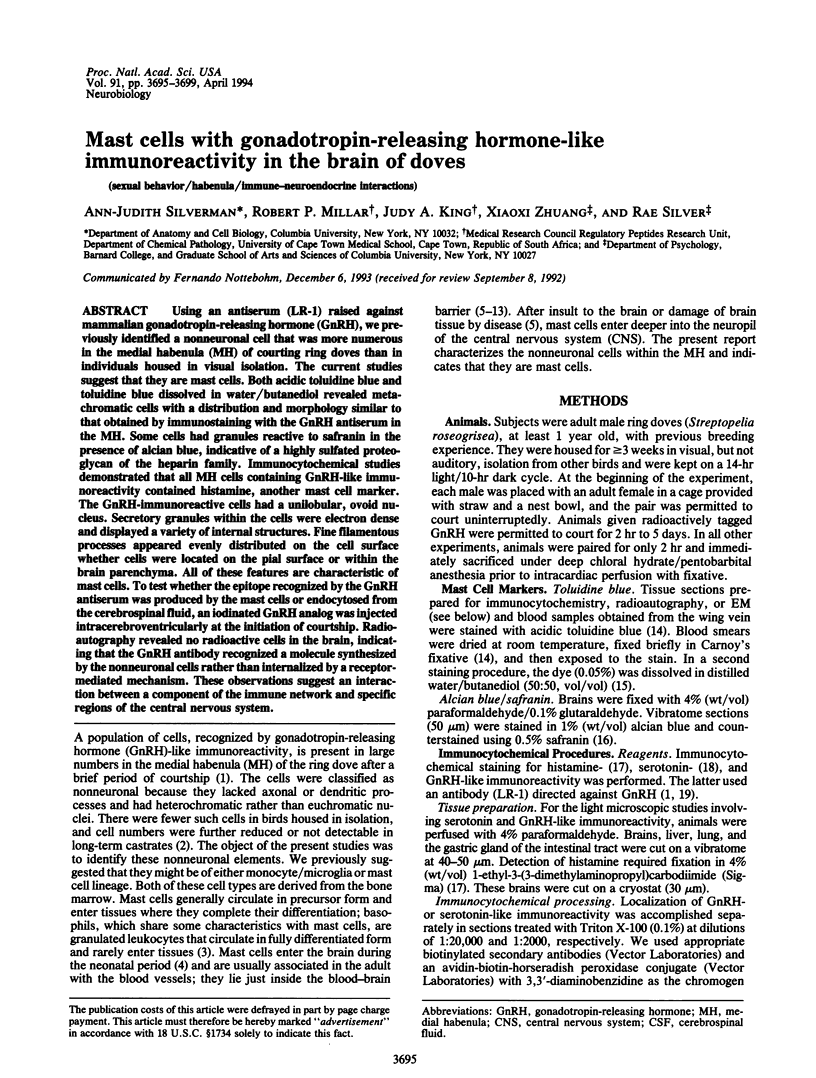
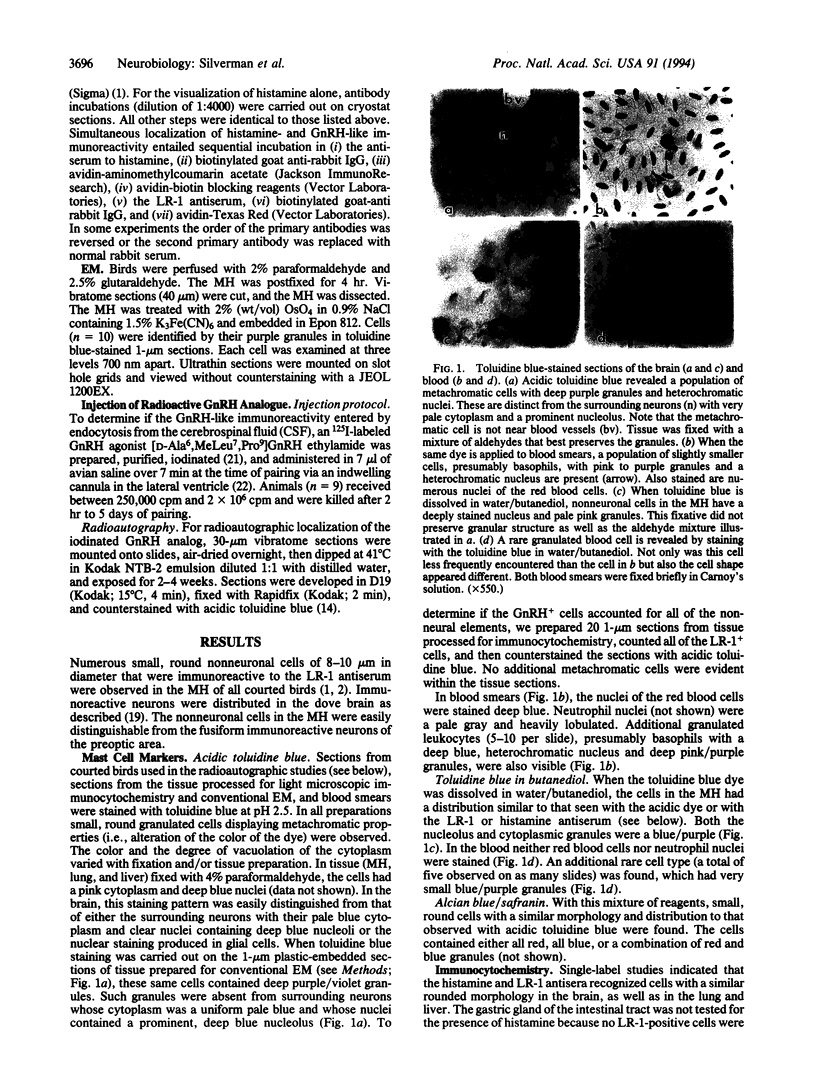
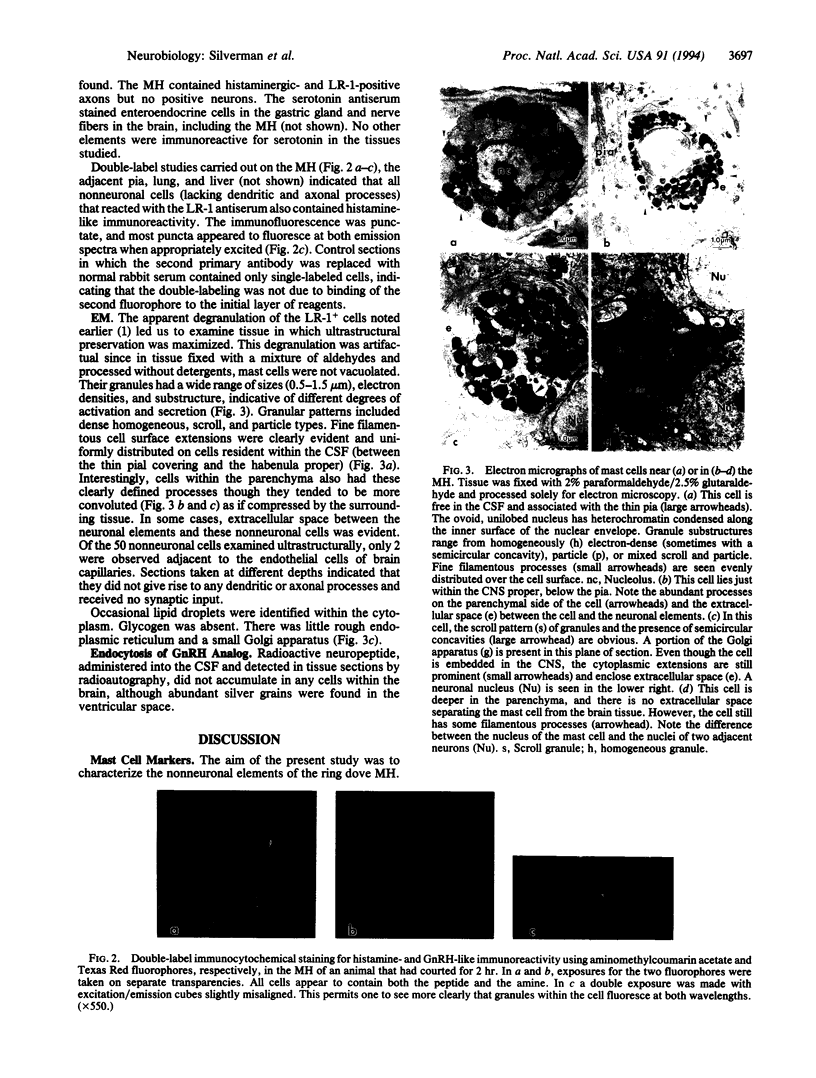
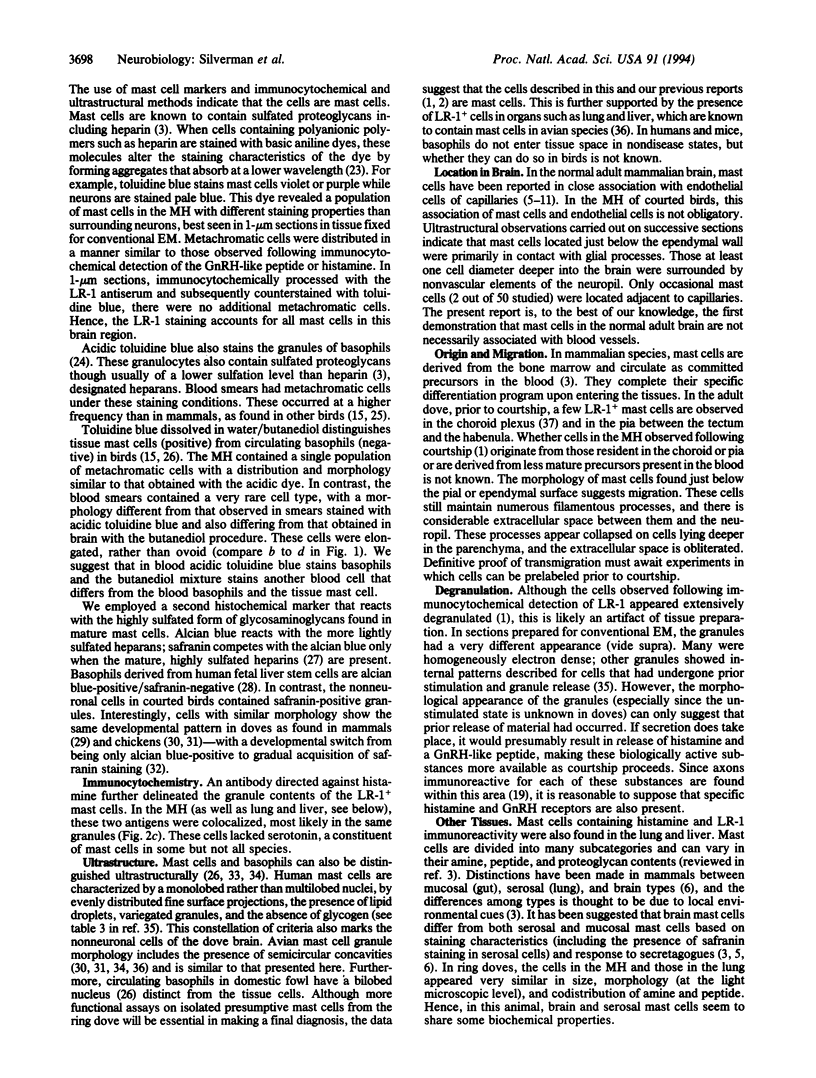
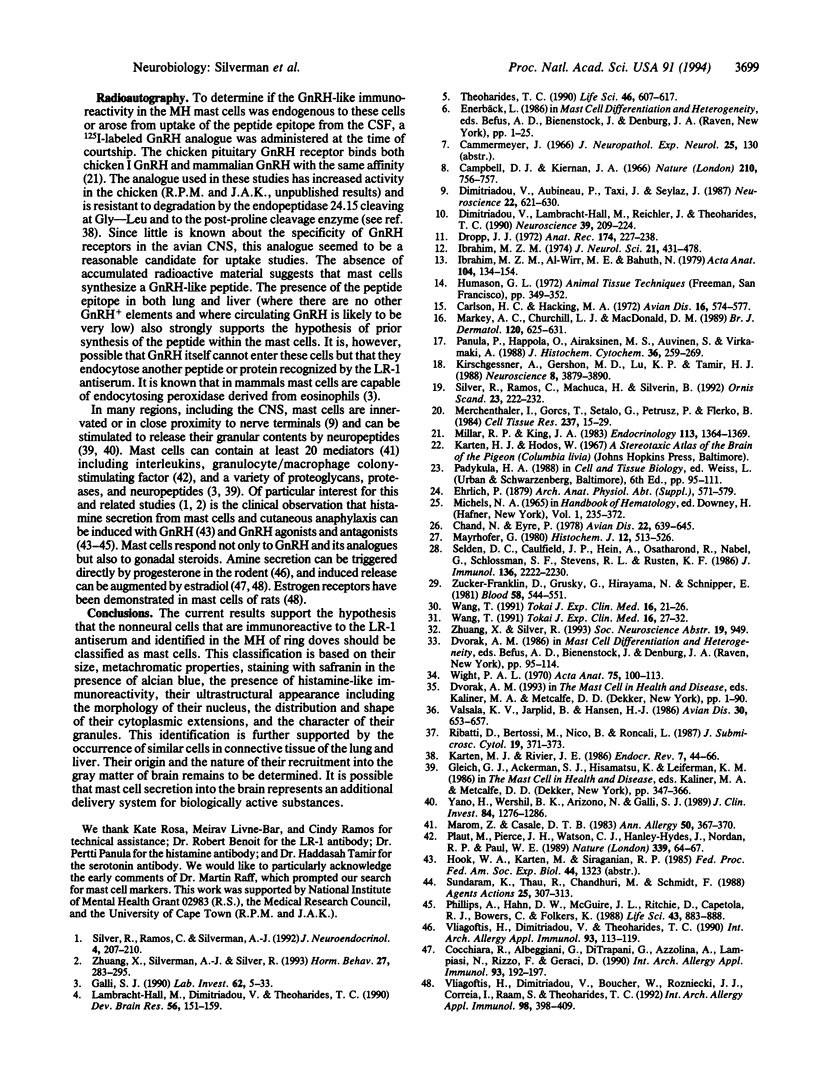
Images in this article
Selected References
These references are in PubMed. This may not be the complete list of references from this article.
- Campbell D. J., Kernan J. A. Mast cells in the central nervous system. Nature. 1966 May 14;210(5037):756–757. doi: 10.1038/210756b0. [DOI] [PubMed] [Google Scholar]
- Carlson H. C., Hacking M. A. Distribution of mast cells in chicken, turkey, pheasant, and quail, and their differentiation from basophils. Avian Dis. 1972 May-Jun;16(3):574–577. [PubMed] [Google Scholar]
- Chand N., Eyre P. Rapid method for basophil count in domestic fowl. Avian Dis. 1978 Oct-Dec;22(4):639–645. [PubMed] [Google Scholar]
- Cocchiara R., Albeggiani G., Di Trapani G., Azzolina A., Lampiasi N., Rizzo F., Geraci D. Modulation of rat peritoneal mast cell and human basophil histamine release by estrogens. Int Arch Allergy Appl Immunol. 1990;93(2-3):192–197. doi: 10.1159/000235300. [DOI] [PubMed] [Google Scholar]
- Dimitriadou V., Aubineau P., Taxi J., Seylaz J. Ultrastructural evidence for a functional unit between nerve fibers and type II cerebral mast cells in the cerebral vascular wall. Neuroscience. 1987 Aug;22(2):621–630. doi: 10.1016/0306-4522(87)90358-7. [DOI] [PubMed] [Google Scholar]
- Dimitriadou V., Lambracht-Hall M., Reichler J., Theoharides T. C. Histochemical and ultrastructural characteristics of rat brain perivascular mast cells stimulated with compound 48/80 and carbachol. Neuroscience. 1990;39(1):209–224. doi: 10.1016/0306-4522(90)90234-u. [DOI] [PubMed] [Google Scholar]
- Dropp J. J. Mast cells in the central nervous system of several rodents. Anat Rec. 1972 Oct;174(2):227–237. doi: 10.1002/ar.1091740207. [DOI] [PubMed] [Google Scholar]
- Galli S. J. New insights into "the riddle of the mast cells": microenvironmental regulation of mast cell development and phenotypic heterogeneity. Lab Invest. 1990 Jan;62(1):5–33. [PubMed] [Google Scholar]
- Ibrahim M. Z., Al-Wirr M. E., Bahuth N. The mast cells of the mammalian central nervous system. III. Ultrastructural characteristics in the adult rat brain. Acta Anat (Basel) 1979;104(2):134–154. doi: 10.1159/000145062. [DOI] [PubMed] [Google Scholar]
- Karten M. J., Rivier J. E. Gonadotropin-releasing hormone analog design. Structure-function studies toward the development of agonists and antagonists: rationale and perspective. Endocr Rev. 1986 Feb;7(1):44–66. doi: 10.1210/edrv-7-1-44. [DOI] [PubMed] [Google Scholar]
- Kirchgessner A. L., Gershon M. D., Liu K. P., Tamir H. Costorage of serotonin binding protein with serotonin in the rat CNS. J Neurosci. 1988 Oct;8(10):3879–3890. doi: 10.1523/JNEUROSCI.08-10-03879.1988. [DOI] [PMC free article] [PubMed] [Google Scholar]
- Lambracht-Hall M., Dimitriadou V., Theoharides T. C. Migration of mast cells in the developing rat brain. Brain Res Dev Brain Res. 1990 Nov 1;56(2):151–159. doi: 10.1016/0165-3806(90)90077-c. [DOI] [PubMed] [Google Scholar]
- Markey A. C., Churchill L. J., MacDonald D. M. Human cutaneous mast cells--a study of fixative and staining reactions in normal skin. Br J Dermatol. 1989 May;120(5):625–631. doi: 10.1111/j.1365-2133.1989.tb01347.x. [DOI] [PubMed] [Google Scholar]
- Marom Z., Casale T. B. Mast cells and their mediators. Ann Allergy. 1983 Jun;50(6):367–370. [PubMed] [Google Scholar]
- Mayrhofer G. Fixation and staining of granules in mucosal mast cells and intraepithelial lymphocytes in the rat jejunum, with special reference to the relationship between the acid glycosaminoglycans in the two cell types. Histochem J. 1980 Sep;12(5):513–526. doi: 10.1007/BF01011925. [DOI] [PubMed] [Google Scholar]
- Merchenthaler I., Görcs T., Sétáló G., Petrusz P., Flerkó B. Gonadotropin-releasing hormone (GnRH) neurons and pathways in the rat brain. Cell Tissue Res. 1984;237(1):15–29. doi: 10.1007/BF00229195. [DOI] [PubMed] [Google Scholar]
- Millar R. P., King J. A. Synthesis, luteinizing hormone-releasing activity, and receptor binding of chicken hypothalamic luteinizing hormone-releasing hormone. Endocrinology. 1983 Oct;113(4):1364–1369. doi: 10.1210/endo-113-4-1364. [DOI] [PubMed] [Google Scholar]
- Panula P., Häppölä O., Airaksinen M. S., Auvinen S., Virkamäki A. Carbodiimide as a tissue fixative in histamine immunohistochemistry and its application in developmental neurobiology. J Histochem Cytochem. 1988 Mar;36(3):259–269. doi: 10.1177/36.3.3343510. [DOI] [PubMed] [Google Scholar]
- Phillips A., Hahn D. W., McGuire J. L., Ritchie D., Capetola R. J., Bowers C., Folkers K. Evaluation of the anaphylactoid activity of a new LHRH antagonist. Life Sci. 1988;43(11):883–888. doi: 10.1016/0024-3205(88)90263-9. [DOI] [PubMed] [Google Scholar]
- Plaut M., Pierce J. H., Watson C. J., Hanley-Hyde J., Nordan R. P., Paul W. E. Mast cell lines produce lymphokines in response to cross-linkage of Fc epsilon RI or to calcium ionophores. Nature. 1989 May 4;339(6219):64–67. doi: 10.1038/339064a0. [DOI] [PubMed] [Google Scholar]
- Ribatti D., Bertossi M., Nico B., Roncali L. Mast cells in the chick embryo choroid plexuses. J Submicrosc Cytol. 1987 Apr;19(2):371–373. [PubMed] [Google Scholar]
- Seldin D. C., Caulfield J. P., Hein A., Osathanondh R., Nabel G., Schlossman S. F., Stevens R. L., Austen K. F. Biochemical and phenotypic characterization of human basophilic cells derived from dispersed fetal liver with murine T cell factors. J Immunol. 1986 Mar 15;136(6):2222–2230. [PubMed] [Google Scholar]
- Sundaram K., Didolkar A., Thau R., Chaudhuri M., Schmidt F. Antagonists of luteinizing hormone releasing hormone bind to rat mast cells and induce histamine release. Agents Actions. 1988 Dec;25(3-4):307–313. doi: 10.1007/BF01965036. [DOI] [PubMed] [Google Scholar]
- Theoharides T. C. Mast cells: the immune gate to the brain. Life Sci. 1990;46(9):607–617. doi: 10.1016/0024-3205(90)90129-f. [DOI] [PubMed] [Google Scholar]
- Valsala K. V., Järplid B., Hansen H. J. Distribution and ultrastructure of mast cells in the duck. Avian Dis. 1986 Oct-Dec;30(4):653–657. [PubMed] [Google Scholar]
- Vliagoftis H., Dimitriadou V., Boucher W., Rozniecki J. J., Correia I., Raam S., Theoharides T. C. Estradiol augments while tamoxifen inhibits rat mast cell secretion. Int Arch Allergy Immunol. 1992;98(4):398–409. doi: 10.1159/000236217. [DOI] [PubMed] [Google Scholar]
- Vliagoftis H., Dimitriadou V., Theoharides T. C. Progesterone triggers selective mast cell secretion of 5-hydroxytryptamine. Int Arch Allergy Appl Immunol. 1990;93(2-3):113–119. doi: 10.1159/000235289. [DOI] [PubMed] [Google Scholar]
- Wang T. Mast cells in the chick digestive tract. I. Development. Tokai J Exp Clin Med. 1991 Mar;16(1):21–26. [PubMed] [Google Scholar]
- Wang T. Mast cells in the chick digestive tract. II. Fixation, distribution, histochemistry and ultrastructure. Tokai J Exp Clin Med. 1991 Mar;16(1):27–32. [PubMed] [Google Scholar]
- Wight P. A. The mast cells of Gallus domesticus. I. Distribution and ultrastructure. Acta Anat (Basel) 1970;75(1):100–113. doi: 10.1159/000143444. [DOI] [PubMed] [Google Scholar]
- Yano H., Wershil B. K., Arizono N., Galli S. J. Substance P-induced augmentation of cutaneous vascular permeability and granulocyte infiltration in mice is mast cell dependent. J Clin Invest. 1989 Oct;84(4):1276–1286. doi: 10.1172/JCI114295. [DOI] [PMC free article] [PubMed] [Google Scholar]
- Zhuang X., Silverman A. J., Silver R. Reproductive behavior, endocrine state, and the distribution of GnRH-like immunoreactive mast cells in dove brain. Horm Behav. 1993 Sep;27(3):283–295. doi: 10.1006/hbeh.1993.1021. [DOI] [PubMed] [Google Scholar]
- Zucker-Franklin D., Grusky G., Hirayama N., Schnipper E. The presence of mast cell precursors in rat peripheral blood. Blood. 1981 Sep;58(3):544–551. [PubMed] [Google Scholar]




